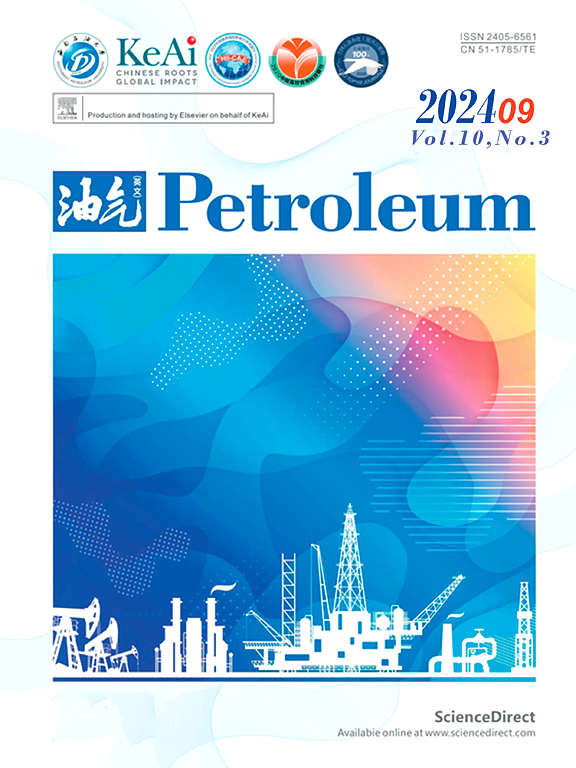含水合物沉积物纳米钻井液体系设计与性能评价
IF 3.5
Q2 ENERGY & FUELS
引用次数: 0
摘要
钻井作业对天然气水合物的勘探和开发至关重要。然而,在特定条件下,钻井液会侵入储层,导致井眼不稳定和测井数据失真。事实证明,纳米颗粒的掺入是一种有效的方法,可以增强钻井液的抗滤和孔隙或裂缝堵塞能力,从而提高井筒稳定性。此外,研究表明,目标浓度的亲水纳米颗粒可以抑制水合物的形成。本研究将亲水纳米caco3颗粒作为钻井液的专用添加剂,提出了一种纳米基水合物钻井液体系。对该改性钻井液的性能和水合物抑制性能进行了综合评价。模拟钻井液的设计配方为:1.0% CMC + 0.1% PAM + 0.1% XC + 5.0% NaCl + 5.0% KCl + 1.0% PVCap + 1.0% ~ 6.0%纳米caco3。设计的钻井液体系胶体稳定性超过97%,密度范围为1.08-1.10 g/cm3。表观粘度为36 ~ 79.5 mPa·s,塑性粘度为27 ~ 42 mPa·s,动剪切力为8.176 ~ 38.325 Pa。纳米颗粒的流变效应与浓度有关,在1-4 wt%时变化最小,在5-6 wt%时显著增加,从而可以根据钻井需求进行性能调整。该流体的pH值约为7,可通过添加碱性物质进行改性。此外,随着纳米颗粒浓度的增加,流体的过滤速率逐渐降低。因此,这种纳米caco3基钻井液体系具有出色的储层保护性能,非常适合于海洋含水合物沉积物的钻井。本文章由计算机程序翻译,如有差异,请以英文原文为准。
Design and performance evaluation of nano-based drilling fluid system for hydrate bearing sediments
Well drilling operations are essential for the exploration and development of natural gas hydrates. However, under specific conditions, drilling fluids can invade reservoirs, leading to borehole instability and distortions in well-logging data. The incorporation of nanoparticles has proven to be an effective method to enhance the anti-filtration and pore or fracture plugging capabilities of drilling fluids, thus improving wellbore stability. Additionally, research has shown that a targeted concentration of hydrophilic nanoparticles can inhibit hydrate formation. This study focuses on hydrophilic nano-CaCO3 particles as specialized additives for drilling fluids and proposes a nano-based hydrate drilling fluid system. The performance and hydrate inhibition of this modified drilling fluid were comprehensively evaluated. The designed formulation for the simulated drilling fluid was determined to be: 1.0% CMC + 0.1% PAM + 0.1% XC + 5.0% NaCl + 5.0% KCl + 1.0% PVCap + 1.0%–6.0% nano-CaCO3. The designed drilling fluid system achieved a colloidal stability exceeding 97%, with a density range of 1.08–1.10 g/cm3. Its apparent viscosity ranged from 36 to 79.5 mPa·s, plastic viscosity from 27 to 42 mPa·s, and dynamic shear force from 8.176 to 38.325 Pa. The rheological effects of nanoparticles are concentration-dependent, with minimal changes at 1–4 wt% and significant increases at 5–6 wt%, enabling performance tuning for drilling needs. The pH value of the fluid was approximately 7, which could be modified by the addition of alkaline substances. Furthermore, as the nanoparticle concentration increased, the fluid's filtration rate progressively decreased. Therefore, this nano-CaCO3-based drilling fluid system demonstrates excellent reservoir protection properties and is well-suited for drilling in marine hydrate-bearing sediments.
求助全文
通过发布文献求助,成功后即可免费获取论文全文。
去求助
来源期刊

Petroleum
Earth and Planetary Sciences-Geology
CiteScore
9.20
自引率
0.00%
发文量
76
审稿时长
124 days
期刊介绍:
Examples of appropriate topical areas that will be considered include the following: 1.comprehensive research on oil and gas reservoir (reservoir geology): -geological basis of oil and gas reservoirs -reservoir geochemistry -reservoir formation mechanism -reservoir identification methods and techniques 2.kinetics of oil and gas basins and analyses of potential oil and gas resources: -fine description factors of hydrocarbon accumulation -mechanism analysis on recovery and dynamic accumulation process -relationship between accumulation factors and the accumulation process -analysis of oil and gas potential resource 3.theories and methods for complex reservoir geophysical prospecting: -geophysical basis of deep geologic structures and background of hydrocarbon occurrence -geophysical prediction of deep and complex reservoirs -physical test analyses and numerical simulations of reservoir rocks -anisotropic medium seismic imaging theory and new technology for multiwave seismic exploration -o theories and methods for reservoir fluid geophysical identification and prediction 4.theories, methods, technology, and design for complex reservoir development: -reservoir percolation theory and application technology -field development theories and methods -theory and technology for enhancing recovery efficiency 5.working liquid for oil and gas wells and reservoir protection technology: -working chemicals and mechanics for oil and gas wells -reservoir protection technology 6.new techniques and technologies for oil and gas drilling and production: -under-balanced drilling/gas drilling -special-track well drilling -cementing and completion of oil and gas wells -engineering safety applications for oil and gas wells -new technology of fracture acidizing
 求助内容:
求助内容: 应助结果提醒方式:
应助结果提醒方式:


